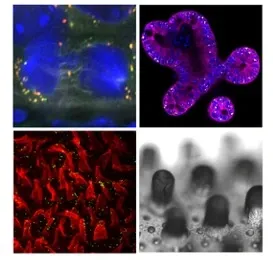Our research
Our body is constantly renewed by tissue specific stem cells, which produce cells undertaking specialized functions and new stem cells maintaining the future renewal capacity. In a young body, such stem cells can easily counter the wear and tear of everyday life by replacing damaged cells with new ones. However, as we age, capacity of stem cells declines, and the resulting drop in tissue repair manifests as the functional decline associated with aging.

Isolated intestinal crypts and villi. The intestinal stem cells are visible in green. The intestinal stem cells and their niche are one of the models used in our lab.
Photo: Pekka Katajisto's Lab
Projects
- ASYMMETRIC SEGREGATION OF ORGANELLES DURING STEM CELL DIVISION
- CELLULAR METABOLISM AND CELL FATE
- IMPACT OF THE STEM CELL NICHE ON AGING

A mouse model that allow temporal labelling of organelles in the the skin (top left) is used to study asymmetric cell divisions of intrinsic factors. Isolated intestinal stem cells and their niche form organoids in vitro (top right), providing a functional assay for niche interactions. Decellularized extracellular matrix can be co-cultured with isolated cells to analyze cell-type specific ECM interactions (bottom left). Organoids can also be cultured in artificial scaffolds (bottom left). This allow us to test different biomaterials or different niche architectures effect stemness.
Photo: N/A
